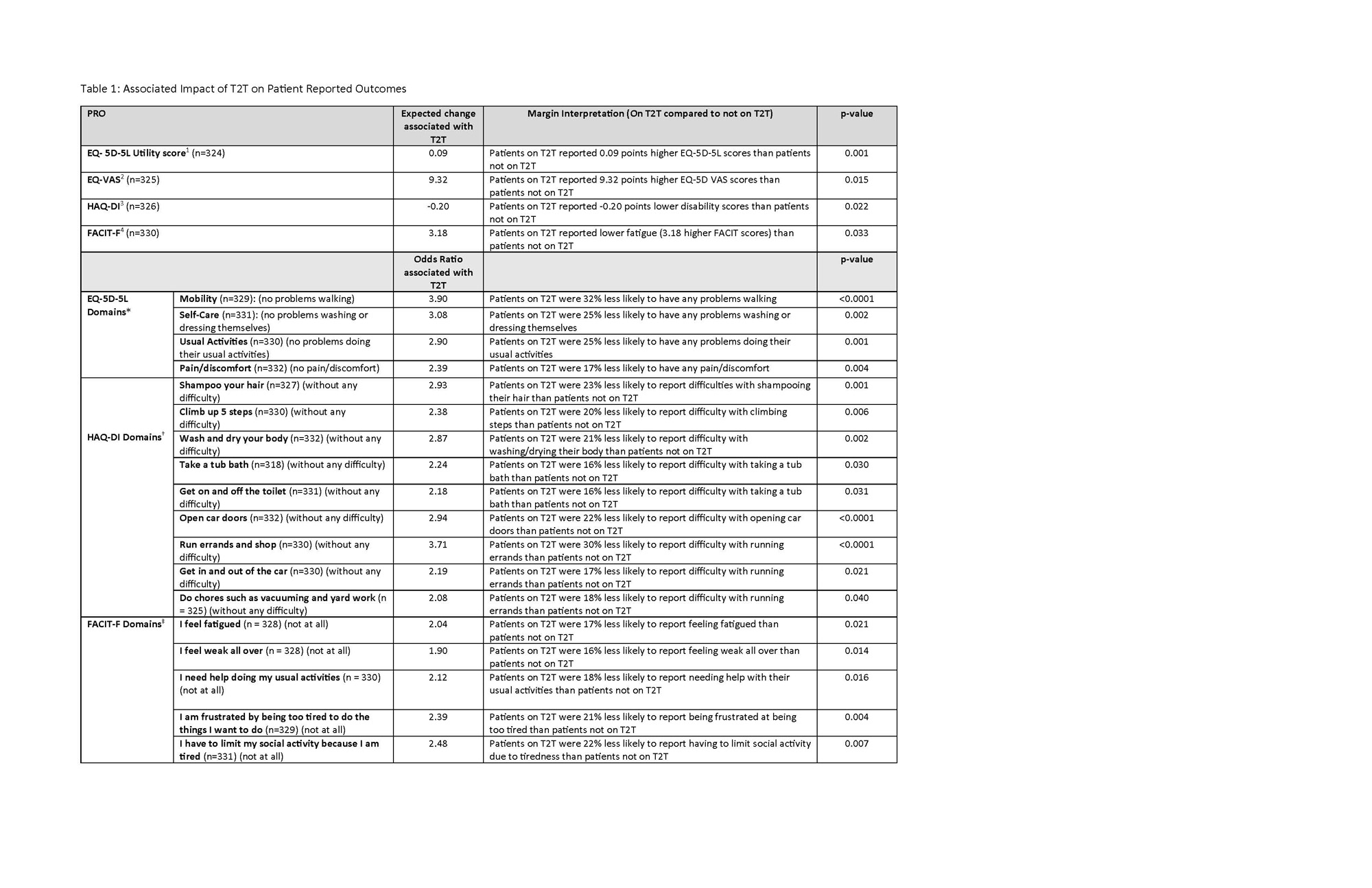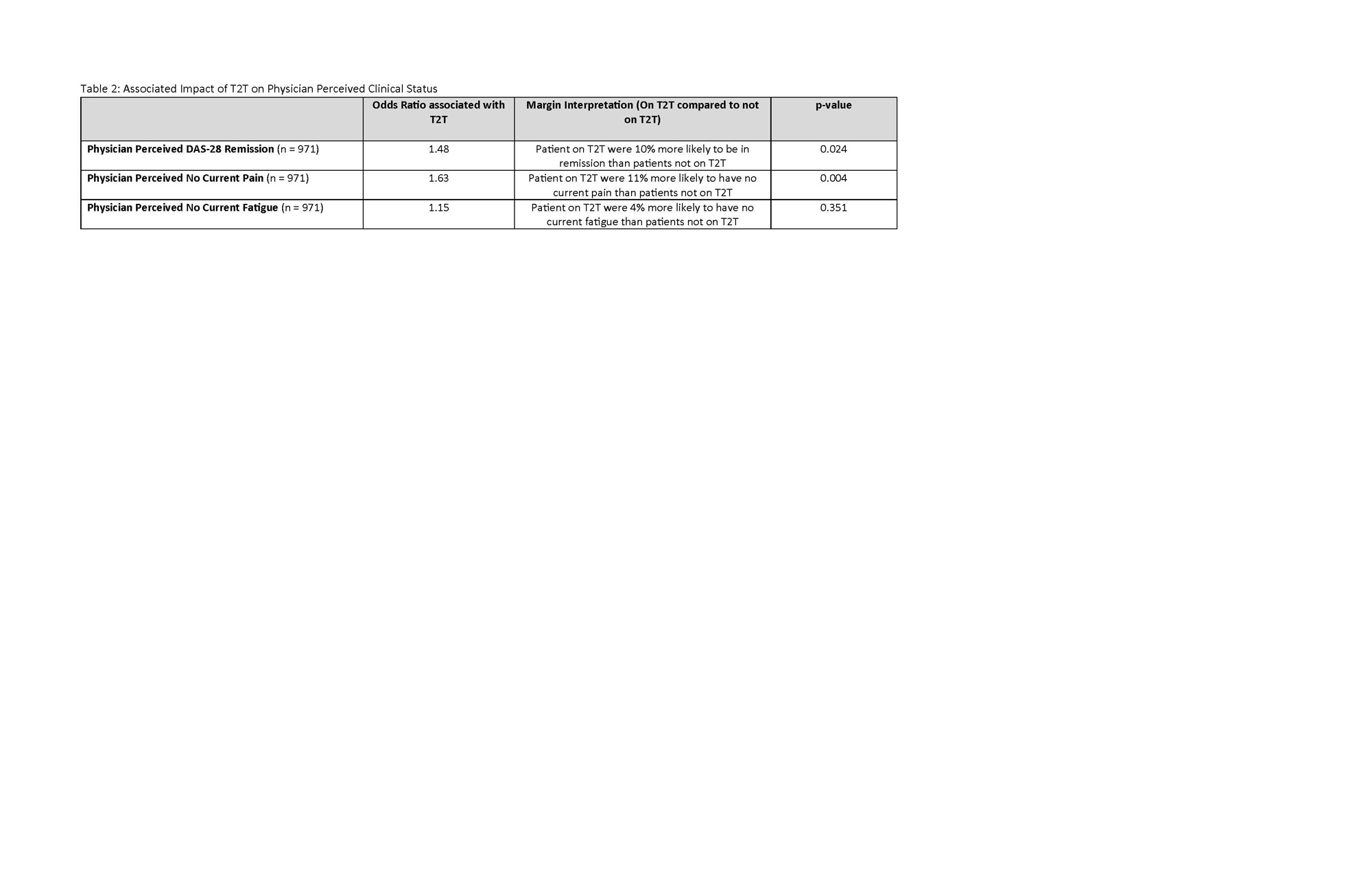Session Information
Date: Sunday, November 12, 2023
Title: (0380–0422) RA – Diagnosis, Manifestations, and Outcomes Poster I
Session Type: Poster Session A
Session Time: 9:00AM-11:00AM
Background/Purpose: Rheumatoid arthritis (RA) is an autoimmune disease affecting the joints, causing swelling, stiffness, and pain that impact a patient’s quality of life. EULAR treatment guidelines suggest using treat-to-target (T2T) for optimal management of RA patients1 with evidence that T2T is effective when used with advanced therapies (AT)2. The clinical benefits of T2T are well studied but evidence for T2T’s impact on patient reported outcomes (PROs) is limited. This study aimed to assess the association between T2T, and PROs and clinician reported outcomes (CROs) for RA patients on AT in real world clinical practice.
Methods: Data were sourced from the Adelphi RA XIII Disease Specific Programme™, a cross-sectional survey with retrospective data collection of rheumatologists and their RA patients in France, Germany, Italy, Spain, and the United Kingdom from June 2021 – February 2022. Physicians reported whether a patient was currently on a T2T approach or not. Sensitivity analyses were conducted with T2T defined more stringently, by including patient T2T goals (remission/low disease activity) and consultation frequency (e.g. ≥3 or 4 in the last 12 months) in the definition. PROs were collected through the EQ-5D-5L, EQ-VAS, Health Assessment Questionnaire Disability Index (HAQ-DI) and Functional Assessment of Chronic Illness Therapy – Fatigue (FACIT-F). CROs included physician perceived disease activity (DAS28 scores: remission = < 2.6; low = 2.6–3.2; moderate = 3.3–5.1; high = >5.1), pain and fatigue (none, mild, moderate, or severe). Multivariate regressions (linear regressions for continuous, ordered logistic regressions for ordinal outcomes) were conducted to assess the impact of T2T on PROs and CROs amongst AT patients. The model was adjusted for age, sex, body mass index, Charlson comorbidity index and physician perceived disease severity at diagnosis.
Results: A total of 971 RA patients were receiving AT at the time of data collection of which 610 (63%) were currently following a T2T approach, of these 72% were female vs 65% who were not on T2T, 90% were white/Caucasian vs 86% and mean (standard deviation) age was 50.6 (12.5) vs 53.1 (13.5) years old, respectively. A T2T approach was associated with significantly higher (better) EQ-5D-5L, EQ-VAS, and FACIT-F scores and lower (better) HAQ-DI scores. Patients on T2T experienced problems with activities of daily living less than patients not on T2T (Table 1). T2T was also associated with significantly greater odds of patients being in physician perceived remission and having no pain (Table 2). Despite the association with better FACIT-F scores, T2T was not significantly associated with less physician perceived fatigue.
Conclusion: T2T in RA was associated with significantly better PROs such as overall and domain scores for EQ-5D-5L, HAQ-DI, and FACIT-F. Patients on T2T reported a greater likelihood of being able to conduct daily activities without difficulties or problems compared to those not on T2T. T2T was also associated with better CROs such as remission and no pain.
References:
- Smolen J. et al., Ann. Rheum. Dis 2020;79:685-699.
- Lampropoulos C. et al., Clin Exp Rheumatol. 2017;35(2):192-200.
PRO key (range): Range in brackets indicates for each PRO whether a higher or lower score is a better outcome for patients
1EQ-5D-5L utility score – Germany Tariff (0.0_1.0)=higher; 2EQ-VAS (1.0_100.0)=higher; 3HAQ-DI (0.0_3.0)=lower; 4FACIT-F (0.0-52.0)=higher.
Margin outputs are calculated using the regression equation and are the predictions for each group if all other covariates are at their mean value. Margin outputs were calculated for patients on T2T and those not on T2T and the difference has been reported.
Odds ratio >1 shows the patient on T2T is more likely to have the outcome = 1 (positive outcome).
PRO domain model outcomes:
*EQ-5D-5L: 0 = I have problems’ (includes ‘Slight problems’, ‘Moderate problems’, ‘Severe problems’, ‘Unable to do’) 1 = ‘I have no problems’.
†HAQ-DI: 0 = With difficulty (includes ‘With some difficulty’, ‘With much difficulty’ and ‘Unable to do’), 1 = ‘Without any difficulty’.
‡FACIT-Fatigue: 0 = Presence of fatigue (‘Includes a little bit’, ‘Somewhat’, ‘Quite a bit’ and ‘Very much’), 1 – ‘Not at all’.
Margin outputs are calculated are calculated from the regression equation seeing the change in outcome for each treatment, while all other covariates are taken as their mean value
To cite this abstract in AMA style:
White D, Kadakia A, Howell O, Strengholt S, Goddard E, Barlow S, Takeuchi T. Association of a Treat-to-Target Management Approach with Physician and Patient Reported Outcomes Among Real – World Patients with Rheumatoid Arthritis Receiving Advanced Therapy in Europe [abstract]. Arthritis Rheumatol. 2023; 75 (suppl 9). https://acrabstracts.org/abstract/association-of-a-treat-to-target-management-approach-with-physician-and-patient-reported-outcomes-among-real-world-patients-with-rheumatoid-arthritis-receiving-advanced-therapy-in-europe/. Accessed .« Back to ACR Convergence 2023
ACR Meeting Abstracts - https://acrabstracts.org/abstract/association-of-a-treat-to-target-management-approach-with-physician-and-patient-reported-outcomes-among-real-world-patients-with-rheumatoid-arthritis-receiving-advanced-therapy-in-europe/


